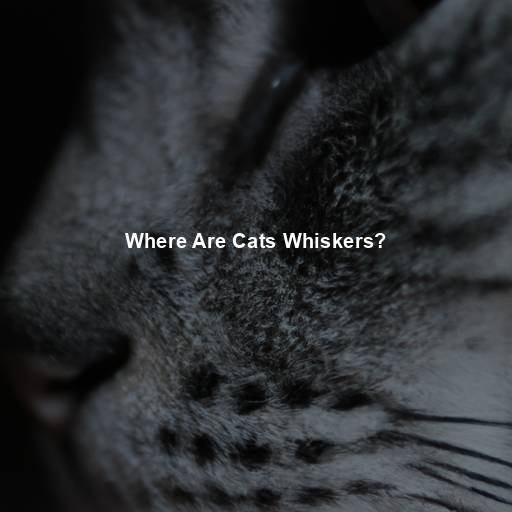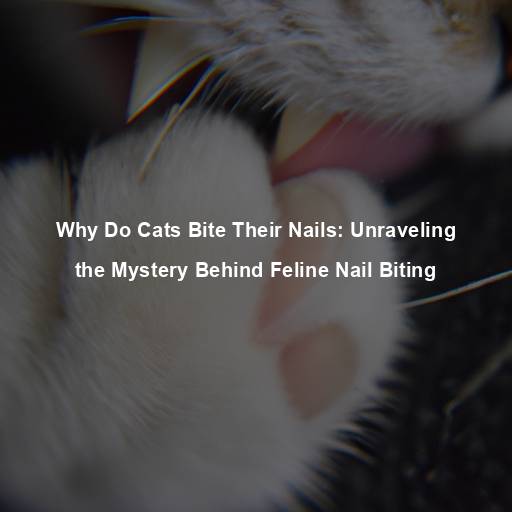Where Are Cats Whiskers?
Last Updated on October 25, 2023 by Evan
Contents [hide]
- 1 Understanding the Mysterious Whiskers of Cats
- 1.1 The Purpose of Whiskers – More Than Just Facial Hair
- 1.2 The Location of Whiskers – From Nose to Toes
- 1.3 The Importance of Whiskers – A Cat’s Sixth Sense
- 1.4 Caring for Whiskers – Handle with Care
- 1.5 The Fascinating World of Whiskers
- 1.6 Ancient Origins – A Trait Passed Down Through Generations
- 1.7 Sensory Adaptation – An Advantage in the Dark
- 1.8 Natural Selection – Survival of the Whiskered
- 2 The Whiskers of Different Cat Breeds
- 3 The Whisker Mystique – A Marvelous Enigma
- 3.1 The Sensitivity of Whiskers – How Much Can They Feel?
- 3.2 Whiskers and Communication – More Than Just Body Language
- 3.3 Whisker Disorders – When Things Go Awry
- 3.4 Hunting with Precision – Ambush and Attack
- 3.5 Nocturnal Adaptation – Owning the Night
- 3.6 Surviving in Challenging Environments – Whiskers as Guides
- 4 Myths and Misconceptions about Whiskers
- 5 The Marvels of Whiskers – A Source of Wonder
- 6 Appreciating the Whiskered Wonders
- 7 FAQs – Where are Cats Whiskers
- 7.1 What are cat’s whiskers and where are they located?
- 7.2 Why do cats have whiskers?
- 7.3 Do all cats have whiskers?
- 7.4 Are cat’s whiskers just like regular hair?
- 7.5 Is it harmful to trim a cat’s whiskers?
- 7.6 Can cat whiskers regrow if they are lost or broken?
- 7.7 Do whiskers indicate a cat’s mood?
- 7.8 Can I touch or play with a cat’s whiskers?
Understanding the Mysterious Whiskers of Cats
Cats are fascinating creatures with unique features that set them apart from other animals. One of the most intriguing aspects of a cat’s anatomy is their whiskers. These long, stiff hairs protruding from a cat’s face not only add to their charm but also serve several important functions. In this article, we will delve into the world of cats’ whiskers, exploring their purpose, location, and why they are such a crucial part of a feline’s sensory arsenal.
The Purpose of Whiskers – More Than Just Facial Hair
Whiskers, scientifically known as vibrissae, are not simply facial hair for cats. They are highly specialized sensory organs that play a vital role in a cat’s daily life. Unlike other types of hair, whiskers are embedded deep within a cat’s skin, connected to nerve endings that send crucial information to their brain.
The Location of Whiskers – From Nose to Toes
Whiskers are not limited to a cat’s face; they can be found in various locations on their body. Let’s explore the different areas where whiskers are commonly found on a cat.
Facial Whiskers – The Most Prominent and Well-Known
When it comes to feline fashion, nothing screams “I’m fabulous”! quite like a cat’s face-framing whiskers. These majestic mystacial whiskers, strategically positioned alongside their upper lip, form a symphony of beauty on each side of their snout, leaving us in awe of their intricate and mesmerizing whisker patterns. It’s a burst of style that only the whiskers of a cat can provide.
Superciliary Whiskers – Above the Eyes
In addition to the facial whiskers, cats also have a set of whiskers above their eyes, known as superciliary whiskers. These whiskers are shorter and less prominent than the mystacial whiskers but still serve a similar purpose.
Cats’ whiskers are not limited to their head; they also have a set of whiskers on their forelimbs. These whiskers, known as carpal whiskers, are located on the back of their forelimbs, near the wrists. While their function is not yet fully understood, it is believed that these whiskers aid in navigation and help cats gauge narrow spaces.
Whiskers on the Back of the Legs – Aiding in Balance
Ever wondered about the mysterious world of cats and their whiskers? As it turns out, these furry feline features aren’t just limited to their adorable faces. In a baffling twist, cats also sport whiskers on the back of their hind legs. Yes, you heard it right!
The Importance of Whiskers – A Cat’s Sixth Sense
Whiskers are often referred to as a cat’s “sixth sense” due to their remarkable abilities. Let’s explore the significance of whiskers in a cat’s life.
Sensing the World – Feeling Their Way Around
Whiskers are incredibly sensitive and can detect even the slightest changes in their environment. They act as feelers, helping cats navigate through tight spaces, such as narrow gaps between furniture or hunting prey in the dark. The flexibility of whiskers allows cats to gauge whether they can fit through a particular opening, preventing them from getting stuck.
Judging Distance – Aiming with Precision
Cats are known for their exceptional jumping and pouncing abilities. Whiskers play a crucial role in these acrobatic feats by helping cats judge distances accurately. The length of a cat’s whiskers is approximately equal to the width of their body. By extending their whiskers forward, cats can gauge whether they can squeeze through tight spaces or make a successful leap.
Emotional Indicators – Mood Mirrors
Cats, those enigmatic creatures, express themselves in more ways than meets the eye. Whiskers, those delicate wisps that adorn their faces, are not just mere adornments. They possess hidden meanings, serving as emotional barometers for our feline friends. When at ease, their whiskers elegantly stretch forward, a sign of tranquility and contentment.
Caring for Whiskers – Handle with Care
Whiskers, those enigmatic sensors adorning our feline friends’ faces, hold far more importance than we once thought. Sensing changes in their surroundings, detecting prey, and even expressing emotions, these delicate appendages are essential to a cat’s well-being. To ensure that we don’t disrupt their feline radar, here are a few tips on how to handle whiskers with the utmost care, ensuring our furry companions remain in tune with the world around them.
Avoid Trimming Whiskers – Let Them Be
It is a well-established understanding among feline enthusiasts that the majestic whiskers adorning our beloved cats should never, under any circumstances, be tampered with or altered. These delicate sensory appendages are not mere accessories but integral tools that provide our feline companions with vital information about their surroundings. To make matters clear, succumbing to the alluring desire of trimming a cat’s whiskers for superficial reasons not only risks causing grave disorientation to these enigmatic creatures but also has the potential to incite genuine distress within their intricate beings. It is imperative, therefore, that we pledge to honor and respect the significance of these whimsical facial adornments, allowing them to thrive and flourish in all their natural glory.
Provide Adequate Space – Respect Their Whisker Zone
Did you know that cats have these amazing whiskers that extend beyond the width of their body? It’s a fascinating feature that helps them navigate and sense their surroundings. And here’s something intriguing – when you’re setting up food or water dishes for your feline friend, make sure to consider the width of their whiskers. Narrow bowls might cause discomfort for them and might even discourage them from having a meal or quenching their thirst.
Gentle Touch – Avoid Disturbing Whiskers
When engaging in delightful companionship with your precious feline friend, it is of utmost importance to be mindful of their exquisite whiskers. These delicate sensory wonders serve as a vital tool for navigation and communication in their whimsical world. Thus, it is essential to refrain from any unwarranted fondling or forceful tugging on these mesmerizing tendrils, as such actions may inflict discomfort or even a tinge of agony upon your enchanting companion. By honoring and cherishing their personal whisker zone, you will not only fortify the profound bond shared but also grant your exquisite feline the ambience of safety and tranquility they so richly deserve.
The Fascinating World of Whiskers
Cats have whiskers that are undeniably fascinating and contribute greatly to their irresistible allure and nimbleness. These extraordinary sensory organs hold secrets that unlock the marvels of a cat’s physicality, leaving us in awe of their complexity. By cherishing and tending to their delicate whiskers, we guarantee our furry companions a life filled with contentment and purpose as they tap into their extraordinary “sixth sense”.
Get ready to be whisked away into the fascinating universe of our feline friends as we embark on a captivating journey, courtesy of PetsRoof.com. Brace yourself for a mind-boggling exploration of the evolutionary marvel that is none other than the humble whiskers. These seemingly innocent facial adornments hold secrets and surprises that will leave you baffled and utterly amazed. Keep your eyes peeled and your curiosity ignited as we dive deep into the enigmatic world of whiskers, uncovering their hidden powers and unraveling the mysteries they hold.
Step into the world of feline fascination as we unravel the enigma of whiskers. Through eons of evolution, these seemingly innocent appendages have transformed into exquisite sensory detectors, guiding cats through the maze of life. Join us on a bewildering journey into the depths of survival, where the allure of whiskers reveals their indispensable role in feline existence.
Ancient Origins – A Trait Passed Down Through Generations
It’s truly captivating to uncover the enigmatic origins of the mesmerizing whiskers that adorn our beloved feline friends. Delving into the depths of ancient history, we unveil the awe-inspiring tale of how these remarkable whiskers have gracefully transformed through the eons. As we peruse the ancient fossil records, we are bewildered to discover that whiskers were not a mere development of the modern-day cats but a prominent feature of their prehistoric ancestors. With each passing era, these once humble whiskers have embarked on an intricate evolutionary journey, adapting with exquisite precision to cater to the diverse needs of various cat species.
Sensory Adaptation – An Advantage in the Dark
It’s no secret that cats have an uncanny ability to conquer the night with their mesmerizing vision. But did you know that whiskers are the unsung heroes behind their nocturnal triumphs? These mysterious tendrils, extending gracefully beyond their bodies, serve as the feline GPS system, helping them maneuver and seize prey in the darkest of corners. With a sensory prowess that can detect the tiniest of motions or hurdles, whiskers grant cats an enigmatic advantage that keeps their predators in perpetual bafflement.
Natural Selection – Survival of the Whiskered
The remarkable journey of feline evolution unravels a tale of survival and adaptation, where the fittest whiskers prevailed. These enigmatic facial appendages emerged as the secret weapon in a cat’s arsenal, granting them a strategic edge in the unforgiving wilderness. Fascinatingly, as time whispered its secrets, these once simple sensory tools transformed into intricate instruments finely tuned for hunting, evading danger, and negotiating treacherous terrains. Behold the captivating saga of how whiskers wove their way into the intricate tapestry of diverse feline species, forever altering their destiny.
The Whiskers of Different Cat Breeds
While all cats have whiskers, there are variations in their appearance and length among different breeds. Let’s explore the whisker characteristics of some popular cat breeds.
Persian Cats – Luxuriously Long Whiskers
Persian cats possess an awe-inspiring beauty that rivals even the most enchanting works of art. Their resplendent, cascading fur captures the imagination, and one cannot help but be captivated by their majestic whiskers. Like delicate tendrils of grandeur, these ethereal whiskers extend harmoniously from their regal faces, adding an air of mystery and elegance to their already enchanting presence.
Siamese Cats – Sleek and Delicate Whiskers
The alluring Siamese felines possess a striking elegance that sets them apart. Just as their sleek and slender bodies captivate the eye, their whisper-thin whiskers add an extra touch of finesse. These delicate filaments, finely crafted, further enrich their already graceful and refined demeanor, like a secret in plain sight.
Maine Coon Cats – Mighty Whiskers for a Mighty Breed
When it comes to Maine Coon cats, there’s no denying their awe-inspiring size, and boy, do their whiskers fit the bill! These regal felines boast whiskers that are robust and oh-so-prominent, perfectly complementing their majestic demeanor. With their long and luxuriously thick whiskers, it’s no wonder these magnificent creatures excel in the art of hunting. Their whiskers truly are the crown jewel of their majestic appearance.
The Whisker Mystique – A Marvelous Enigma
Whiskers, those enigmatic appendages adorning our feline friends, remain shrouded in bewilderment and fascination. As dedicated scientists immerse themselves in the captivating world of whiskers, a tapestry of unanswered questions unravel before them. With every probe and examination, fresh revelations emerge, shedding light on the intricate purpose and immense impact of these delicate sensory tools in the complex lives of our beloved cats.
The Sensitivity of Whiskers – How Much Can They Feel?
Have you ever wondered just how sensitive whiskers really are? Well, scientists are currently unraveling the mysterious world of whisker sensitivity, trying to decipher the secrets of these incredible sensory organs that cats possess. With their intricate mechanisms and fascinating abilities, whiskers play a crucial role in how cats perceive and navigate their surroundings. The ongoing research in this field only deepens the sense of wonder and perplexity surrounding this unique feline feature.
Whiskers and Communication – More Than Just Body Language
Cats communicate in various ways, and whiskers play an essential role in this communication system. Beyond body language, cats can use their whiskers to convey emotions and intentions to other cats and even humans. Understanding the subtleties of whisker positioning and movement can provide valuable insights into a cat’s communication repertoire.
Whisker Disorders – When Things Go Awry
While whiskers are generally robust and resilient, certain conditions can affect their health and functionality. Whisker disorders, such as whisker fatigue or whisker loss, can cause discomfort and disrupt a cat’s sensory abilities. Recognizing and addressing these conditions is crucial for maintaining a cat’s overall well-being.
Hunting with Precision – Ambush and Attack
In the untamed realm, hunting becomes a relentless dance of survival. Whiskers, delicate yet indomitable, become a feline’s compass in this bewildering pursuit. With their graceful presence, these tactile wonders aid in the stealthy endeavors of stalking prey and navigating through the labyrinthine thicket. Bestowing a sixth sense upon wild cats, the wisps of whiskers vigilantly sense the capricious winds and uncover hidden obstacles, empowering these majestic predators to orchestrate victorious ambushes and unleash agile assaults.
Nocturnal Adaptation – Owning the Night
Many wild cat species are nocturnal or crepuscular, meaning they are most active during the night or twilight hours. Whiskers are particularly advantageous for these cats, as they enhance their night vision and sensory perception. With their heightened sensitivity, wild cats can effectively navigate in the darkness, detecting prey and avoiding potential dangers.
Surviving in Challenging Environments – Whiskers as Guides
The untamed felines of the wild, mighty and free, roam across a tapestry of landscapes as varied as the colors of a painter’s palette. With their ever-vigilant whiskers serving as nature’s compass, they navigate through the thick foliage with an air of confidence and poise. Through intricate pathways, like secret threads interwoven in the grand tapestry of life, these whiskers guide them, revealing hidden openings and potential escape routes. And when faced with desolate terrains, devoid of life’s vibrant tapestry, these mystical whiskers work their magic, measuring distances and uncovering the subtlest ripples in the earthly canvas.
Myths and Misconceptions about Whiskers
Curiosity piques as feline mystique unravels, unraveling the enigmatic realm of cats’ whiskers. As whispers dance through whimsical tales, it’s time to unveil the truth and shatter the veils of misconception. Brace yourselves as we dive deep into the untangled secrets, demystifying the mystical tendrils that adorn our feline friends’ faces.
Myth: Whiskers Indicate a Cat’s Age
It seems like there’s a misconception about using whiskers as a foolproof indicator of a cat’s age. Whiskers, although fascinating, cannot be solely relied upon to determine a feline’s years. Various factors, including individual differences and breed variations, affect the length and thickness of these fascinating facial features. While some changes may occur in older cats’ whiskers as they age gracefully, it’s important to remember that whiskers are not a definitive age-ometer.
Myth: Trimming Whiskers Makes Cats Less Agile
Did you know that tinkering with a cat’s whiskers can have some bizarre consequences? While trimming their whiskers may not directly impact their ability to pounce, it can actually throw their entire perception of the world into a state of utter confusion. It’s like robbing them of their built-in GPS system! So, let’s be respectful and honor those magnificent whiskers that add to a cat’s overall well-being.
Myth: Whiskers Always Indicate a Cat’s Mood
While whiskers can provide some insight into a cat’s emotional state, they should not be solely relied upon as mood indicators. Various factors, such as body language and vocalizations, contribute to understanding a cat’s feelings. Whisker position alone does not provide a comprehensive understanding of a cat’s mood.
The Marvels of Whiskers – A Source of Wonder
Whiskers are not just functional tools; they are also a source of wonder and fascination. Their unique characteristics continue to intrigue scientists and cat enthusiasts alike. Let’s explore some of the remarkable aspects of whiskers that make them truly marvelous.
Whisker Sensitivity – Beyond Human Perception
Have you ever wondered about the extraordinary abilities of a cat’s whiskers? These seemingly simple facial features hold an astonishing level of sensitivity, surpassing our human perception by leaps and bounds. With their uncanny knack for detecting even the faintest shifts in their surroundings, whiskers grant cats an unparalleled insight into their environment. From deciphering minuscule air movements to capturing subtle vibrations and textures, these mystical whiskers serve as a feline superpower, constantly feeding cats with a rich tapestry of sensory information.
Whisker Regeneration – A Remarkable Ability
Whiskers, those extraordinary facial fibres of our feline friends, possess a baffling quality that sets them apart from regular hairs – they possess a unique structure that enables them to bounce back after being damaged or lost. This extraordinary trait ensures that our beloved cats can always rely on their remarkable sensory skills, even in the unfortunate event of broken or trimmed whiskers. Although it may seem like a perplexing process, whisker regrowth typically requires a patient wait of several weeks.
Whisker Diversity – Unique to Each Cat
Just like fingerprints, each cat’s whisker pattern is unique to them. Whiskers can vary in length, thickness, and arrangement, adding to the individuality of every feline. This diversity highlights the complexity and adaptability of whiskers across different cat breeds and species.
Appreciating the Whiskered Wonders
Whiskers are a testament to the marvels of nature and the intricacies of cat anatomy. By understanding and appreciating the significance of whiskers, we can deepen our connection with our feline companions and provide them with the care and respect they deserve. Let us continue to marvel at the wonders of whiskers and celebrate the extraordinary bond between humans and their whiskered friends.
Discover the mesmerizing universe of feline wonders and unlock the enigmatic realm of whiskers on PetsRoof.com, an exquisite sanctuary for all pet aficionados. Immerse yourself in the perplexing charm of cats as we embark on a captivating journey, revealing the spellbinding secrets hidden within their bewitching whiskers. Gather round and begin your adventure on PetsRoof.com, where the fascinating allure of our feline companions awaits.
FAQs – Where are Cats Whiskers
What are cat’s whiskers and where are they located?
Have you ever wondered about the captivating enigma of a cat’s whiskers? These long, thick, and mysteriously stiff hairs possess a stunning secret – they are the masterful sensory conduits that elevate felines to a realm of heightened perception. Acting as gateways to a hidden network of nerve endings, whiskers equip our feline friends with an unparalleled ability to decipher the secrets of their surroundings. Positioned in an intricate pattern on the sides of their nose, above their entrancing eyes, and even on the enigmatic expanse of their forelegs, these mesmerizing features unlock the captivating mysteries of a cat’s extraordinary perception.
Why do cats have whiskers?
There’s more to cats’ whiskers than meets the eye (or paw, as they might say). It’s not just about looking fancy or adding a touch of elegance to their already charming faces. These wispy whiskers serve a multitude of purposes that weave together like a mysterious feline tapestry. From guiding them through the shadowy corners of their domain to alerting them to even the slightest breeze, these delicate sensors are essential tools in the grand scheme of cat life. They help our furry friends gauge spatial awareness, detect nearby movements, and enable them to accurately judge the distance between them and their next tasty target. So, the next time you find yourself marveling at the bewitching beauty of a cat’s whiskers, remember that there’s a hidden world of fascinating functionality behind those enigmatic bristles.
Do all cats have whiskers?
Intriguingly, whiskers, those enigmatic appendages, are an inseparable component of every feline’s anatomy. These mystical, protruding filaments grace the faces of cats across a myriad of breeds, leaving size and coat color unaffected by their presence. Bewilderingly, it is worth noting that the actual length of these whimsical whiskers might differ amidst individual cats and various breeds, adding a touch of delightful curiosity to these already beguiling creatures.
Are cat’s whiskers just like regular hair?
Did you know that whiskers are not just regular hairs on a cat’s body? Interestingly, these special hairs, scientifically known as vibrissae, have distinct characteristics that set them apart. Unlike ordinary hairs, whiskers are thicker, stiffer, and deeply rooted in unique hair follicles. What’s even more fascinating is that these whiskers are connected to nerve cells, making them highly sensitive to even the tiniest touch or movement. So, next time you spot a cat, take a moment to appreciate the mystery and complexity of their incredible whiskers!
Is it harmful to trim a cat’s whiskers?
It is not recommended to trim or cut a cat’s whiskers. Whiskers are an integral part of a cat’s sensory system, and they provide vital information to the cat about their surroundings. Trimming or removing their whiskers can cause disorientation, confusion, and affect their overall well-being. It is important to let a cat’s whiskers grow naturally and avoid any unnecessary interference.
Can cat whiskers regrow if they are lost or broken?
Have you ever wondered if a cat’s whiskers can actually regrow? Well, the answer might surprise you. It turns out that, yes, these delicate appendages can indeed make a comeback if they get lost or broken. However, don’t expect an overnight miracle – whisker regrowth takes time and patience. During this perplexing period, a cat might experience fluctuations in their sensory perception, as they navigate the world without fully matured whiskers.
Do whiskers indicate a cat’s mood?
Whiskers, those fascinating appendages of our feline friends, serve a more sensory purpose rather than being direct indicators of their mood. However, like a complex puzzle, deciphering a cat’s emotions involves piecing together various body language cues, whiskers included. Picture a content cat basking in tranquility, its whiskers assuming a nonchalant position. But when fear or aggression looms, those whiskers transform into fiercely extended antennas, pointing firmly forward. By delicately decoding the intricate language of a cat’s body, whiskers and all, we can unlock a deeper understanding of their ever-shifting moods.
Can I touch or play with a cat’s whiskers?
It is generally best to avoid playing with or touching a cat’s whiskers directly. Whiskers are highly sensitive and serve an important purpose for cats. Pulling or tugging on a cat’s whiskers can cause discomfort or even pain to the cat. It is essential to respect a cat’s personal space and allow their whiskers to serve their natural function without unnecessary interference.







